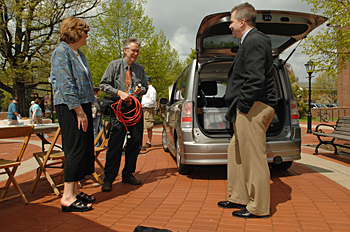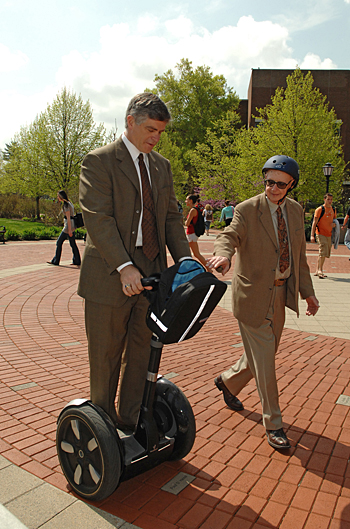
Also on display were UD's zero-emission fuel cell bus powered by hydrogren and “vechicle-to-grid” electric car, which besides not relying on gasoline has the added potential of serving as an ancillary service provider to utility companies during peak usage spikes.
“What we're trying to do is provide a fleet of electric vehicles to be used as ancillary service providers,” said Nat Pearre, a doctoral-level engineering student at UD who works in the Vehicle-to-Grid Power research program on campus with Willett Kempton, UD associate professor of marine and Earth studies and urban affairs and public policy.
Using electric cars as energy sources for power grids during peak draw times would mean reducing the load (and therefore the burning of coal and carbon dioxide emissions) on over-loaded distribution feeders when energy demands are high, Pearre explained. The electric car displayed on Wednesday, a Scion xB model modified by the company AC Propulsion, used as its power sources a battery, an electrical current and a motor. For display purposes, the hood was popped and cables were hooked up to a breaker box and meter system on loan from Delmarva Power's Electric Meter Department.
Tabitha Groh, a communications specialist in the financial and information services division of UD's Department of Administrative Services, along with Julie Robinson, a marketing and development representative from PhillyCarShare, were helping to get the word out about the car share program's coming to UD next fall.
“We're starting the PhillyCarShare program on campus next fall,” Groh said, “and we're promoting that and trying to get people signed up ahead of time.”
Robinson added that there will be two cars, most likely be Toyota Priuses, and said that the idea of the car share program is to improve the environment while liberating people financially.

Brandon Owens, an outreach representative for DART's Rideshare program, said that the UD community's movement toward sustainability has boosted interest in programs such as DART's Ozone Awareness Days bus passes and a pre-tax dollar incentive to use public transportation initiated by the IRS.
“We want to let people know that taking public transportation can reduce congestion and improve air quality,” he said. “For every bus, it's four cars off the road.”
Also during the event, Burnaby Munson, C. Eugene Bennett Professor of Chemistry and Biochemistry, offered rides on his Segway, the two-wheeled human transporter.
Gasoline-free and public transportation were just two of many sustainability themes featured throughout Earth Week at UD. Others included water conservation, electricity conservation and recycling.
Article by Becca Hutchinson
Photos by Kathy Atkinson

